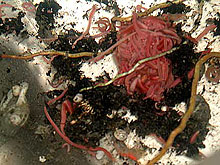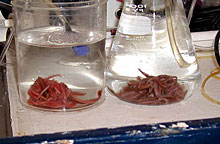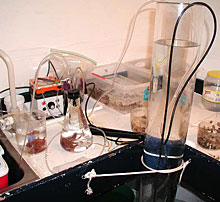
The orbiniids can be kept on board in a tank of sea water. They tend to group and form balls, as they do in their natural environment. If you look closely, you can see the well-developed gills on either side of the anterior part (bright red). Click image for a larger view.
Respiratory Adaptations
October 12, 2002
Stephane Hourdez
Pennsylvania State University
At cold seeps, the oxygen levels are usually below normal levels (this is called “hypoxia”). Yet, the animals living there require as much oxygen as any other similar species. How do they get the oxygen they need from an environment that has little? I have been studying this question for some time. The main species of worms I work on is called Methanoaricia dendrobranchiata (I know, this is terrible to pronounce so let’s call it by its family name: Orbiniid). These orbiniids are mobile: they can move to another area when the conditions are not good enough. But most of the time, they have to deal with hypoxia.
From previous studies, we can list a few adaptations that these orbiniids use in their low-oxygen environment. The first one is quite obvious when you look at these worms. They have very well developed gills compared to species of the same family living in well-oxygenated water. This increases the surface area through which they can take up oxygen from the environment. These gills also have special features that make them very good at gas exchange. The second adaptation is the presence of a hemoglobin with a high affinity for oxygen. That means that even when there is little oxygen in the environment, this hemoglobin can bind oxygen. Again, this will facilitate oxygen uptake.
Even with all these adaptations, it is unlikely that they will have enough oxygen for their needs. So they will rely on anaerobiosis. This means that their cells will have to produce energy in absence of oxygen. This is a very inefficient way to produce energy: starting from a sugar molecule, this produces 10-20 times less energy than when you have oxygen. This may seem wasteful but they don’t really have any choice. Why don’t they just go elsewhere? Well, the deep-sea is pretty poor in food and, in the area, the cold seep communities are the richest: there is plenty of food so you can waste some by a poor energy production.

This is a close-up of the two chambers with worms. You can see the difference of color between the worms under normoxia (on the left) and the browner color of the worms under hypoxia (on the right). Click image for a larger view.
Sign up for the Ocean Explorer E-mail Update List.
























